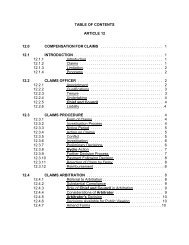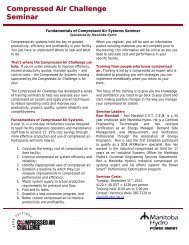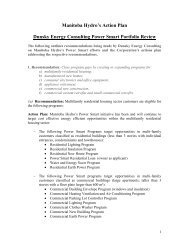Power Smart for Business: Using Energy Wisely in ... - Manitoba Hydro
Power Smart for Business: Using Energy Wisely in ... - Manitoba Hydro
Power Smart for Business: Using Energy Wisely in ... - Manitoba Hydro
Create successful ePaper yourself
Turn your PDF publications into a flip-book with our unique Google optimized e-Paper software.
Water<br />
Pre-r<strong>in</strong>se spray valves<br />
Switch to energy efficient spray valves<br />
Standard pre-r<strong>in</strong>se valves flow at 11 to 15 litres<br />
per m<strong>in</strong>ute, while energy efficient “low-flow” valves<br />
use under five litres per m<strong>in</strong>ute (55 to 65 per cent<br />
less water.) An energy efficient pre-r<strong>in</strong>se valve<br />
can reduce your water and energy bills, while still<br />
clean<strong>in</strong>g dishes effectively.<br />
Toilets<br />
A toilet that cont<strong>in</strong>ues to run after flush<strong>in</strong>g<br />
can waste up to 200,000 litres of water <strong>in</strong><br />
a s<strong>in</strong>gle year.<br />
Reduce toilet water use and <strong>in</strong>stall toilet retrofit<br />
devices. Facilities may wish to experiment with<br />
various devices, such as early closure devices <strong>for</strong><br />
flappers. By us<strong>in</strong>g identical toilets, you can determ<strong>in</strong>e<br />
which will result <strong>in</strong> the most reasonable <strong>in</strong>vestment.<br />
Consider:<br />
• water saved;<br />
• ease of <strong>in</strong>stallation;<br />
• <strong>in</strong>cidence of multiple flush<strong>in</strong>g, cost, and<br />
• water saved per flush.<br />
Various retrofit devices may work better <strong>in</strong> certa<strong>in</strong><br />
brands of toilets than <strong>in</strong> others. Payback often<br />
occurs with<strong>in</strong> one year.<br />
Target toilets <strong>in</strong> high traffic areas <strong>for</strong> replacement<br />
with ultra low flow toilets (six litres per flush).<br />
If it is not obvious which toilets have the highest<br />
usage, <strong>in</strong>stall count mechanisms.<br />
Fix toilet leaks.<br />
To check <strong>for</strong> a toilet leak, put a non-toxic and nonsta<strong>in</strong><strong>in</strong>g<br />
dye <strong>in</strong> the toilet tank. Wait fifteen m<strong>in</strong>utes.<br />
If the dye seeps <strong>in</strong>to the toilet bowl (no flush<strong>in</strong>g),<br />
you have a toilet leak. The most common cause is a<br />
flapper that needs to be replaced.<br />
Determ<strong>in</strong>e flow rate of toilets <strong>in</strong> litres per flush.<br />
This may be noted between the seat attachments<br />
and the tank; or note the make, model, and year<br />
made. If toilet was made prior to 1985, it uses more<br />
than 13 litres per flush; significantly older toilets can<br />
use 20 or more litres per flush. Modern low flow<br />
toilets use six to 13.5 litres per flush.<br />
19











